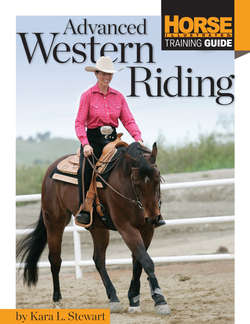Читать книгу Advanced Western Riding - Kara L Stewart - Страница 6
ОглавлениеIntroduction
Since taking up western riding, you’ve dedicated yourself to learning more of the details of riding well and improving your riding skills and abilities. No longer a beginner, you’re now able to sit confidently at the walk, the jog, and the lope; direct your horse; and influence her speed. But, as you’ve probably discovered, there is more to being a good rider than just staying in the saddle, steering, and stopping.
Now, you want to be more than a steady passenger; you want to be a partner with your horse. You want to have the type of relationship with your horse that the advanced riders you admire have with their horses. Horse and rider seem to move to the same thoughts, with invisible cues, ease, comfort, and happiness. Talented amateurs and professional trainers make this look easy. For them, riding seems to be a dance. Will you ever ride like that? Can you ever develop such a deep partnership with your horse? The answer is yes! It will take dedication, work, and commitment on your part, but it won’t happen overnight. If you persevere and keep the right mind-set, you will reach your goal.
It’s helpful, though not essential, to take regular lessons with a trainer who encourages you and keeps raising the bar as you progress. A good trainer can spot areas in which you’re struggling, help you work through these issues and push you a little further than you might push yourself if you were riding on your own.
Don’t rely on your trainer completely, however. A large part of becoming an advanced western rider is honing your abilities and building your confidence and knowledge, so one day you will be able to train a horse yourself. As you continue learning, you’ll want to develop your own style of horsemanship, one that fits with who you are and is based on the type of partnership you want to have with your horse.
Working with a trainer can help you progress, but you should also develop your own horsemanship skills.
In your quest to become an advanced rider, remember that you can’t force the learning process or shorten the length of time it will take to become the rider you seek to be. But you can ensure that you keep improving by putting in the saddle time, not taking shortcuts, getting strong in the basics, and continuing to refine what you know.
Although there is no substitute for hard, dedicated work, there is one more critical aspect to becoming an advanced rider: your mind-set. At a certain point, you may find that riding becomes less about cues and technique and more about mentally connecting with your horse, riding with her rather than simply on her.
In this book, we’ll explore some ideas that will help you refine your riding and open the door to a lifetime of improving your skills. The only limitations are your confidence in yourself and the goals you set for yourself and your horse. First, we’ll look at some of the mental aspects of riding that set advanced riders apart; then we’ll discuss ways to refine your riding by developing better balance, aids, and timing, as well as cover areas you may not be as familiar with, such as your breathing, intent, and focus.
Then, we’ll explore advanced work such as self-carriage in you and your horse, collection, transitions, and lateral movement. You’ll also learn more about tack and the importance of correct saddle fit. And you will get tips for preparing for various types of competitions, from horse shows to cattle work. Finally, you will learn about other ways to have fun with your equine partner.
So ride all you can and practice seriously but joyfully! Riding is a gift, and it’s meant to be fun. Keep smiling, no matter what and, above all, enjoy the journey.
